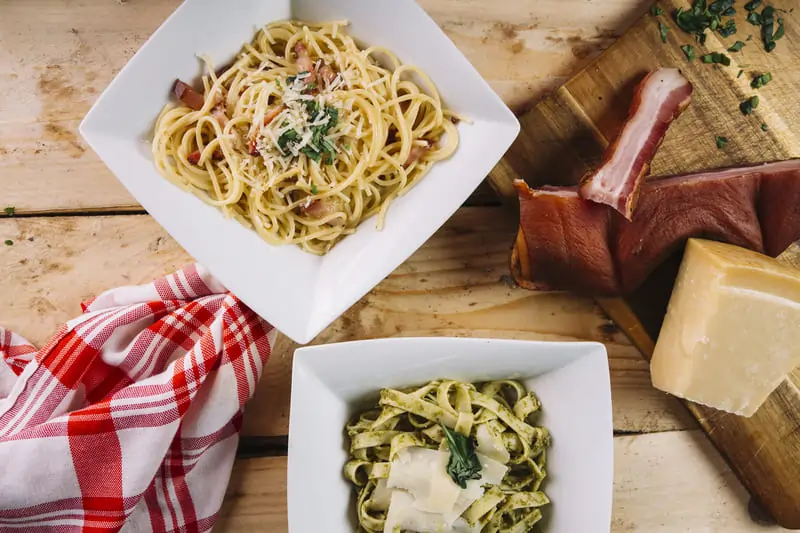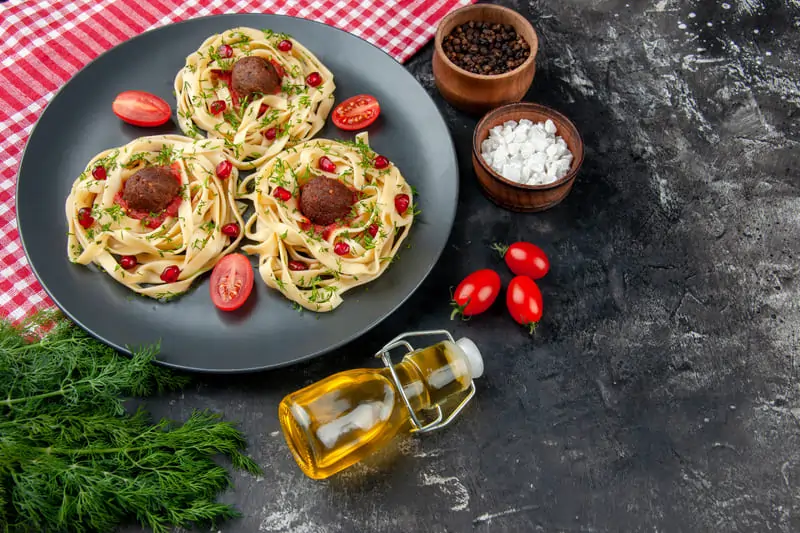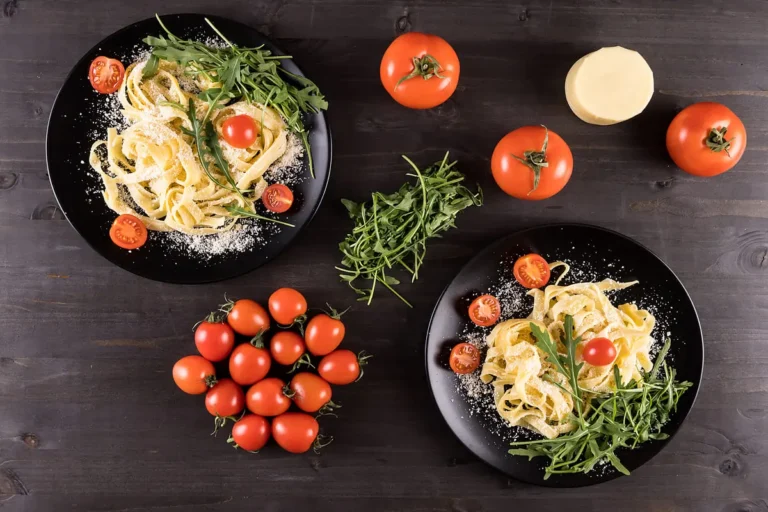Difference between Fettuccine Alfredo and Fettuccine Carbonara when it comes to Italian pasta dishes, few are as beloved or as commonly confused as Fettuccine Alfredo and Fettuccine Carbonara. While both dishes boast creamy, indulgent textures, they are distinctly different in flavor, preparation, and cultural origins. If you’ve ever wondered what sets these two classics apart, this guide breaks it down ingredient by ingredient, technique by technique.
Introduction to Alfredo and Carbonara
Both Fettuccine Alfredo and Fettuccine Carbonara have become global favorites for their rich flavors and satisfying textures. However, their differences often leave people curious. Alfredo is known for its buttery, creamy richness, while Carbonara delivers a savory and smoky profile.
Before diving deeper, let’s define these dishes:
- Fettuccine Alfredo: A pasta dish made with a simple sauce of butter, cream, and Parmesan cheese.
- Fettuccine Carbonara: A Roman classic combining eggs, Pecorino Romano, pancetta or guanciale, and black pepper.
If you’re interested in mastering Carbonara, don’t miss the step-by-step guide on how to make fettuccine carbonara.
Core Ingredient Comparison
Understanding the ingredients of each dish is essential to appreciating their distinctiveness.
Ingredients in Fettuccine Alfredo The beauty of Alfredo lies in its simplicity. This dish’s core ingredients work harmoniously to create a rich and comforting experience:
- Butter: This dairy staple forms the creamy base of the sauce, melting smoothly to coat the pasta evenly.
- Heavy Cream: Integral to the dish, heavy cream enhances the sauce with its rich, luxurious texture.
- Parmesan Cheese: Known for its nutty and savory flavor, Parmesan adds depth and complements the creamy elements perfectly.
- Optional Additions: Ingredients such as garlic add a subtle kick, while parsley can introduce a fresh, herbal note. For those looking for a heartier meal, protein options like chicken are popular additions, blending well with the creamy sauce.
For more ideas on crafting creamy, savory pasta dishes that are both simple and sophisticated, explore our guide to unique creamy pasta recipes.
Ingredients in Fettuccine Carbonara In contrast, Carbonara relies on a different set of ingredients, each contributing to its robust and rustic charm:
- Eggs: The backbone of Carbonara’s sauce, eggs bind the ingredients together, creating a silky, rich coating for the pasta.
- Pecorino Romano: This hard cheese, with its sharp and salty flavor profile, offers a bold taste that is distinctly Italian.
- Pancetta or Guanciale: These cured meats deliver a smoky depth, infusing the dish with a layer of savory complexity.
- Black Pepper: Freshly cracked black pepper not only enhances the dish’s flavor but also adds a subtle heat that balances the richness of the other ingredients.
Carbonara’s bold flavors stand in salty and smoky contrast to Alfredo’s mild and creamy profile, offering a distinctly different culinary experience. For those intrigued by the rich history and variations of this dish, learn more about the origins and evolution of Carbonara.
Preparation Techniques for Fettuccine Alfredo and Carbonara

Both Fettuccine Alfredo and Carbonara require specific techniques that bring out their unique flavors and textures. Mastering these methods will help you achieve authentic and delicious results.
Cooking the Pasta
Fettuccine Alfredo:
Boil the Pasta: Begin by boiling the fettuccine in a large pot of generously salted water. Cook until al dente, which means the pasta is tender yet still slightly firm to the bite.
Reserve Pasta Water: Before draining, save a cup of the pasta water. This starchy water is often used to adjust the sauce’s consistency.
Fettuccine Carbonara:
Boil the Pasta: Similar to Alfredo, cook the fettuccine in salted boiling water until al dente.
Reserve Pasta Water: Reserve about a cup of the water after cooking, as it will be integral in creating the silky texture of the Carbonara sauce.
Preparing the Sauce
Fettuccine Alfredo:
Create the Base: In a separate pan, melt butter over medium heat. Add heavy cream and whisk together, heating until the mixture is warmed through.
Combine with Cheese: Gradually add grated Parmesan cheese to the cream mixture, stirring continuously until the cheese melts into a rich, smooth sauce.
Fettuccine Carbonara:
Render the Pancetta: In a large skillet, cook the pancetta or guanciale until it is crispy. This not only renders out the fat needed for flavor but also prepares the meat for integration into the final dish.
Prepare the Egg Mixture: In a bowl, whisk together egg yolks, Pecorino Romano cheese, and a generous amount of black pepper until well combined.
Combining Ingredients
Fettuccine Alfredo:
Mix Pasta and Sauce: Toss the drained pasta directly into the pan with the Alfredo sauce, stirring well to ensure each strand is coated evenly. Use the reserved pasta water to adjust the sauce’s consistency if necessary.
Fettuccine Carbonara:
Combine Pasta with Meat: Add the drained pasta to the pan with the rendered fat and crisped pancetta, tossing to coat.
Incorporate Egg Mixture: Remove the pan from heat to prevent the eggs from scrambling. Pour the egg and cheese mixture over the pasta, stirring quickly and continuously. Gradually add reserved pasta water to achieve a creamy consistency without cooking the eggs.
Final Touches
Fettuccine Alfredo:
Season and Serve: Adjust the seasoning with salt and pepper if needed, and serve the pasta hot, garnished with extra Parmesan and a sprinkle of parsley for a touch of color.
Nutritional and Dietary Differences

While both Fettuccine Alfredo and Fettuccine Carbonara offer a taste of Italian indulgence, their nutritional content and suitability for various diets vary notably.
Fettuccine Alfredo: This dish is famously rich, high in calories and saturated fat due to its generous use of butter and heavy cream. Parmesan cheese, another key ingredient, adds additional fat but also contributes calcium and protein. While delicious, those monitoring calorie intake might consider portion control or modifications to the traditional recipe.
Fettuccine Carbonara: In comparison, Carbonara is slightly lighter, though still indulgent. It relies on eggs and Pecorino Romano or Parmesan cheese for its creamy texture, offering a higher protein content thanks to the eggs and the addition of pancetta or guanciale. The use of eggs instead of cream results in a lower fat content, making it a somewhat lighter option.
Adjustments for Special Diets
For those with dietary restrictions, both dishes can be adapted to fit vegetarian and vegan diets with a few creative substitutions:
- Vegetarian Options:
- Carbonara: Replace the pancetta or guanciale with mushrooms to maintain the umami and texture. Mushrooms offer a meaty texture and rich flavor that complements the creamy sauce.
- Alfredo: Simply omit any additional protein like chicken to keep the focus on the creamy sauce and pasta.
- Vegan Alternatives:
- Alfredo: Use plant-based alternatives such as vegan butter and a rich, creamy plant-based substitute for heavy cream. Vegan Parmesan or nutritional yeast can replicate the cheesy flavor.
- Carbonara: Tofu or cashew cream can replace the eggs, and vegan cheese substitutes will add the necessary creaminess without dairy.
For more culinary creativity and to discover simple pasta recipes that accommodate a variety of dietary needs, check out our collection of adaptable pasta dishes.
Cultural and Historical Context
Both Fettuccine Alfredo and Fettuccine Carbonara not only delight the palate but also carry rich histories that enhance their global appeal, each story adding layers of cultural significance to these beloved dishes.
Origins of Fettuccine Alfredo The creation of Fettuccine Alfredo dates back to the early 20th century in Rome, crafted by a chef named Alfredo di Lelio. This dish was initially made to comfort his pregnant wife with its simple yet rich ingredients. Its fame skyrocketed when Hollywood stars visiting Rome brought their love for the dish back to the United States. This transatlantic journey transformed Fettuccine Alfredo from a local specialty into an international sensation, synonymous today with Italian luxury in culinary form.
Origins of Fettuccine Carbonara Similarly rooted in Rome, the origin of Fettuccine Carbonara is often linked to the resourcefulness of the Italian people during World War II. The dish is a testament to making do with what was available—a simple yet hearty combination of eggs, cured meat, and cheese. These ingredients, which were more accessible during the war, came together to create a dish that is both satisfying and symbolic of Italian culinary ingenuity during times of hardship.
For those interested in diving deeper into the storied pasts of these dishes and exploring more about traditional Italian culinary practices, check out our guide to authentic Italian pasta creations.
Frequently Asked Questions
What makes Alfredo creamy while Carbonara is silky?
Alfredo’s creaminess comes from heavy cream and butter, while Carbonara’s silkiness relies on egg yolks emulsified with pasta water. If you want to try making the perfect Carbonara sauce, check out this guide on how to make fettuccine carbonara.
Can I use cream in Carbonara?
Traditional Carbonara avoids cream to maintain authenticity, but modern adaptations sometimes include it.
Which is easier to prepare for beginners?
Fettuccine Alfredo is simpler and more forgiving, while Carbonara requires careful attention to avoid overcooking the eggs. If you’re new to pasta making, consider this step-by-step Alfredo guide to get started.
What pasta shapes work best for each dish?
Fettuccine is traditional for both, but spaghetti or linguine can also be used, particularly for Carbonara. Learn more about pairing pasta shapes with sauces in this comprehensive pasta guide.
Are Alfredo and Carbonara interchangeable?
Not entirely. Their distinct flavors and textures suit different palates and occasions. However, if you love experimenting, check out this article on creative pasta combinations.
Conclusion
While Fettuccine Alfredo and Fettuccine Carbonara share similarities in their Italian roots and comforting nature, they are vastly different dishes. Alfredo delivers creamy, mild indulgence, while Carbonara offers savory, smoky richness. Whether you prefer one over the other depends on your taste and mood—but both are sure to satisfy pasta lovers everywhere.
For another Italian classic, explore this guide on perfecting lasagna recipes.

